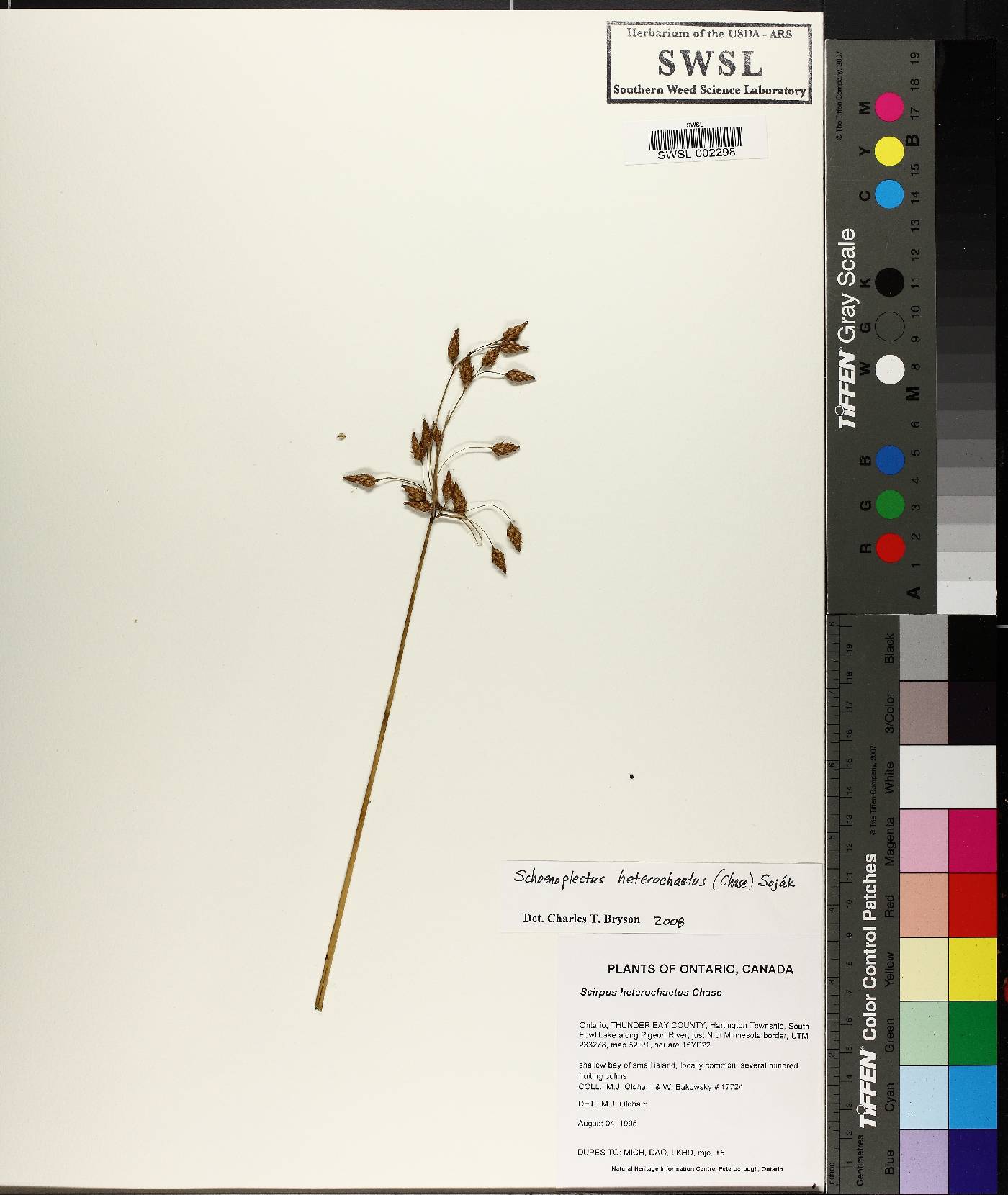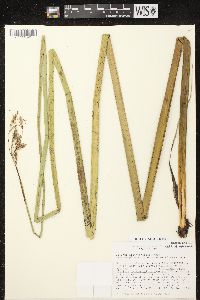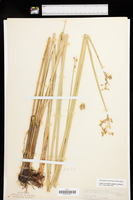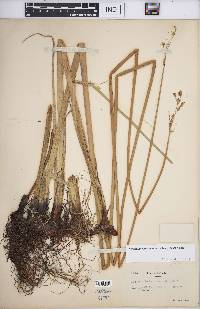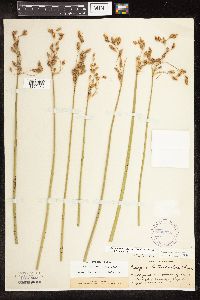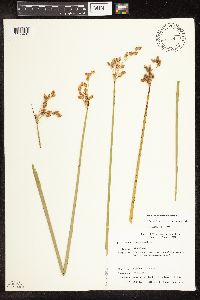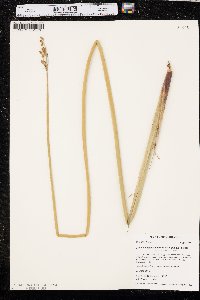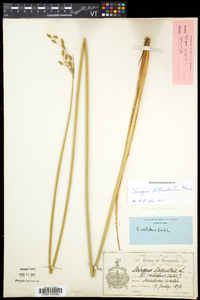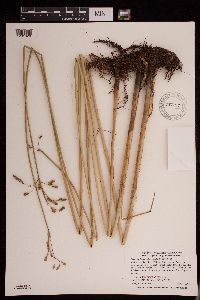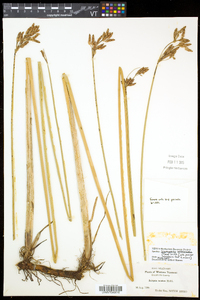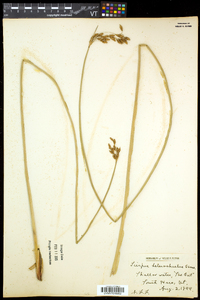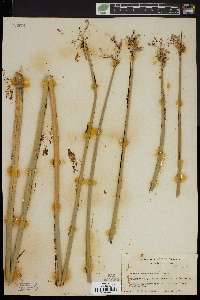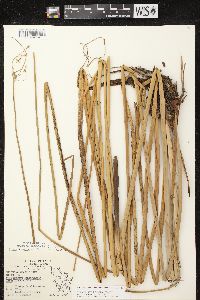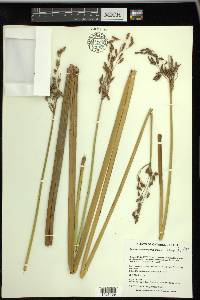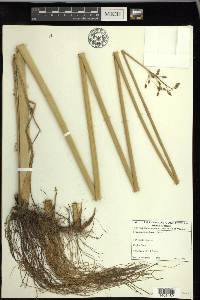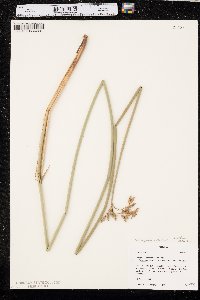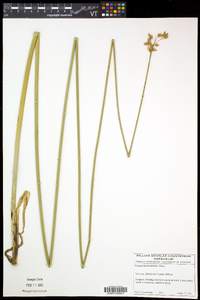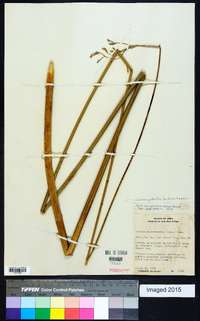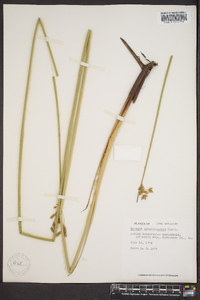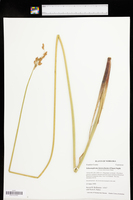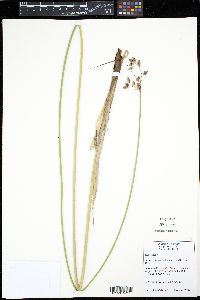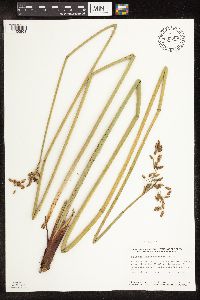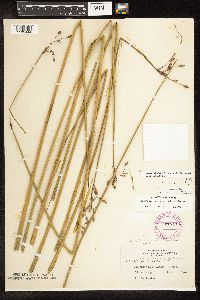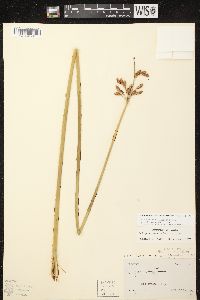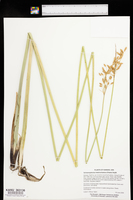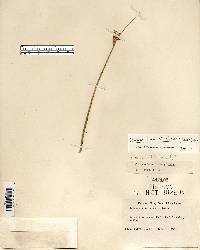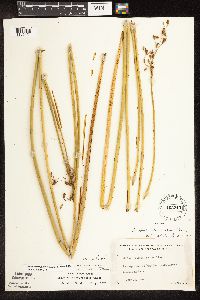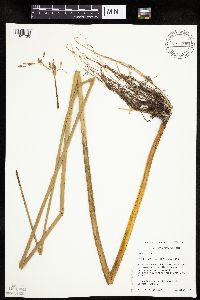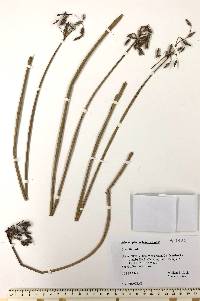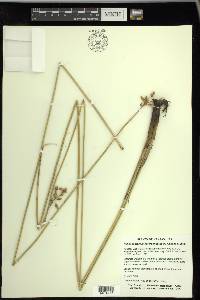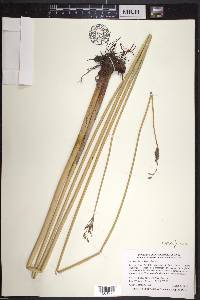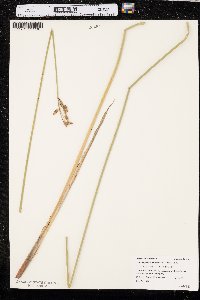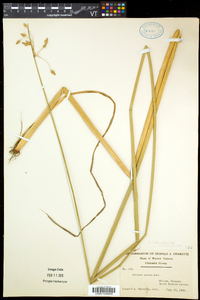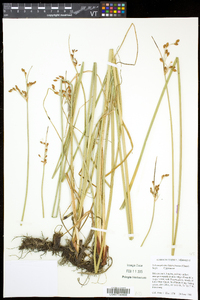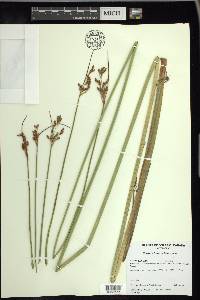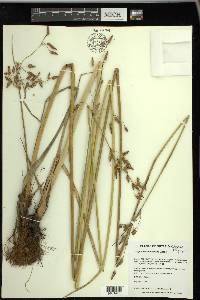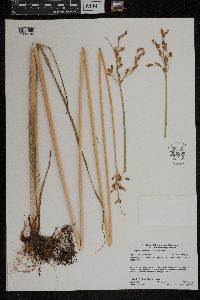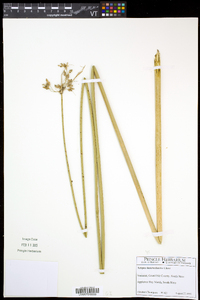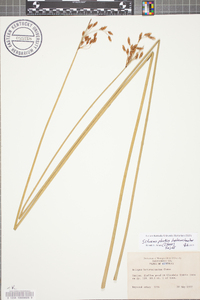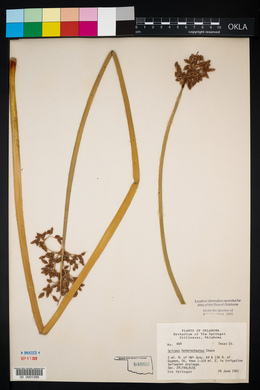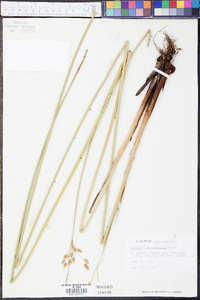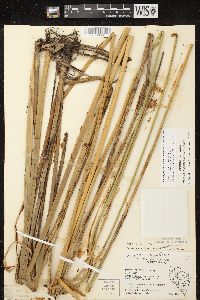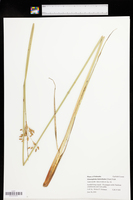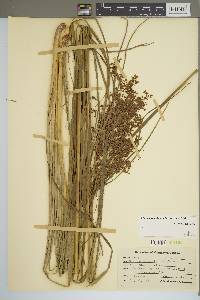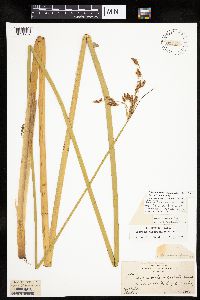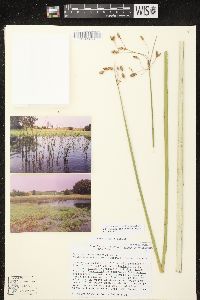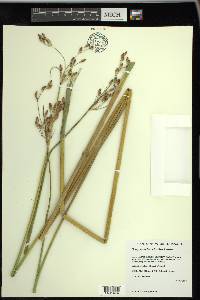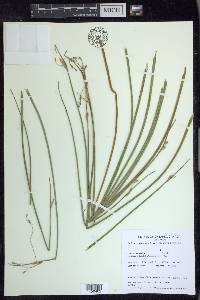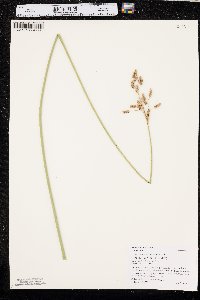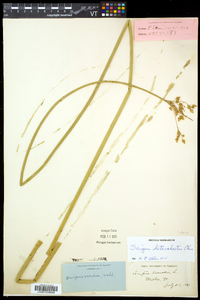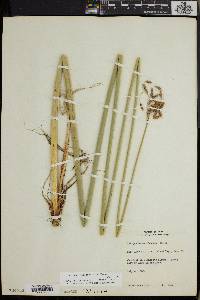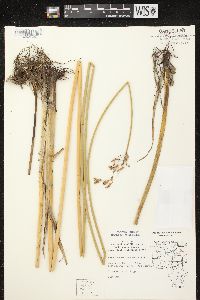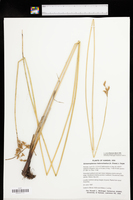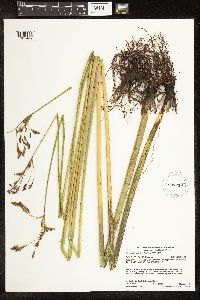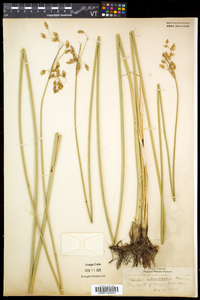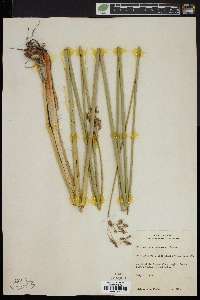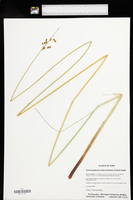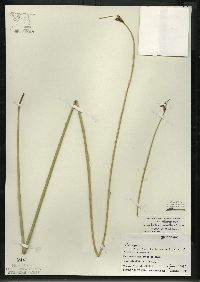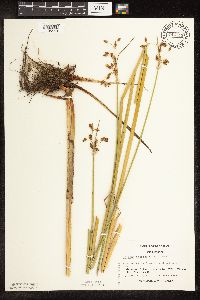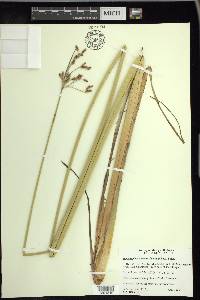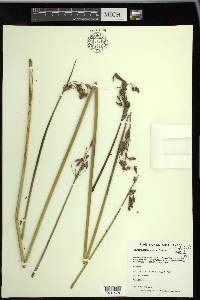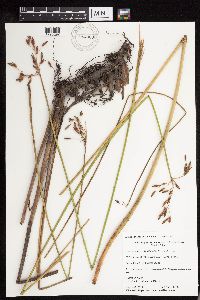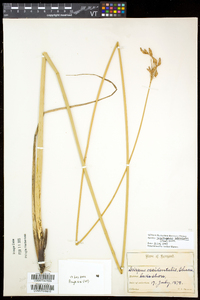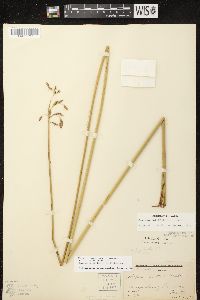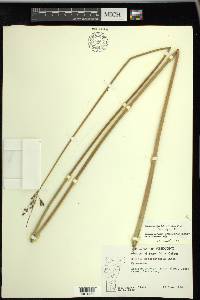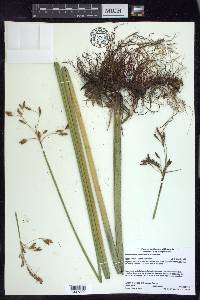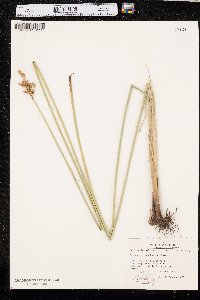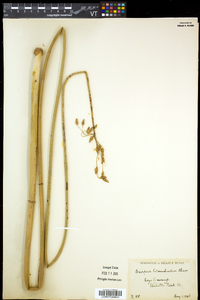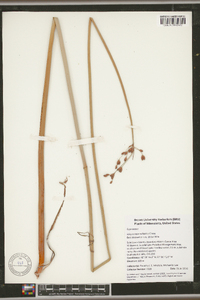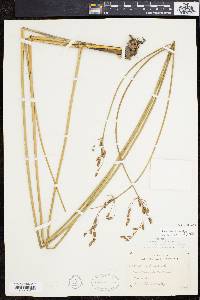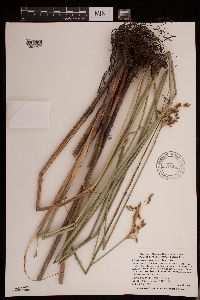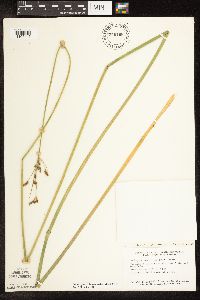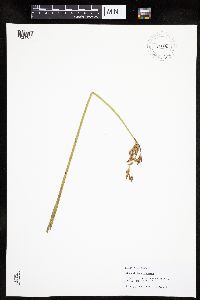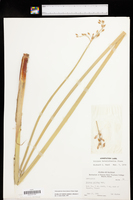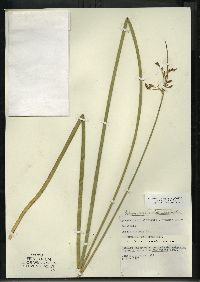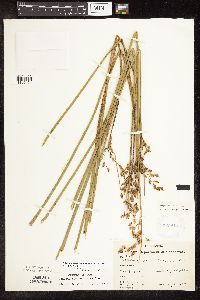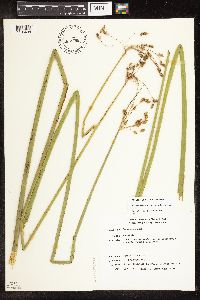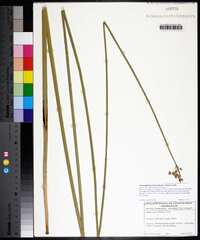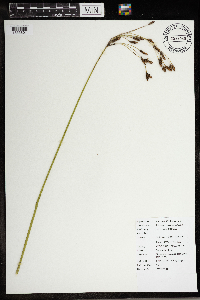
|
|
|
|
Family: Cyperaceae
Pale Great Wood Club-Rush, more...slender bulrush
[Scirpus heterochaetus Chase] |
Rhizomes 5-8 mm diam.; scales longer than internodes, disintegrating to fibers. Culms cylindric, 1.5-2.5 m × 4-8 mm. Leaves basal; sheaths often separating from culm, resembling blade, sometimes reddish proximally, front membranous-translucent, splitting, and delicately pinnate-fibrillose, orifice adaxially deeply V-shaped; ligules entire, 1 mm; blades 1-2, thinly C-shaped to thin and dorsiventrally flat in cross section, much shorter to longer than sheath, distal blade to 220 × 5 mm. Inflorescences 2× branched, open, plano- to concavo-convex, to 9 cm; proximal bract usually erect, thickly C-shaped to subterete in cross section, 1-15 cm, margins often scabridulous. Spikelets 5-30, solitary or rarely 2 together, 5-15 × 3-4 mm; scales light orange-brown to nearly colorless, usually obscurely lineolate-spotted, midribs often greenish, ovate-oblong, 3-4 × 1.5 mm, sparsely reddish- or straw-colored-scabrous distally on awn, sometimes midrib, and rarely adjacent parts of sides, margins ciliate, hairs contorted, flanks veinless, apex obtuse, notch 0.5 mm deep, awn straight to slightly contorted, 0.3-1 mm. Flowers: perianth members 4(-5), brown, bristlelike, equaling achene body or adaxial and abaxial much shorter, sparsely retrorsely spinulose; anthers 2 mm; styles 3-fid. Achenes dark gray-brown, compressed-trigonous, obovoid, 2.2-3.2 × 1.4-1.9 mm; beak 0.3-1 mm. 2n = 38. Fruiting summer. Fresh, often calcareous marshes and lakes, often emergent in water to 1.5 m; 10-500(-2000) m; Alta., Man., Ont., Que.; Calif., Idaho, Ill., Iowa, Kans., Mass., Mich., Minn., Mo., Mont., Nebr., N.Y., N.Dak., Okla., Oreg., Pa., S.Dak., Vt., Wis., Wyo. Schoenoplectus heterochaetus hybridizes with S. acutus and S. tabernaemontani (see comment under 1. S. tabernaemontani). The Michigan record is dubious, the Oregon record is from 1895, and reports from Washington are apparently based on misidentified specimens. Some specimens from scattered localities in Eurasia may be Schoenoplectus heterochaetus. Schoenoplectus lacustris (Linnaeus) Palla, of Eurasia, was collected near Camden, New Jersey, in 1889 and 1891; it now appears to be extirpated. It is also in cultivation in North America and should be sought. It is similar to S. heterochaetus, from which it differs in its often clustered spikelets, six long perianth bristles, and ability to form submerged ribbon-leaved forms, especially in flowing water in streams. 2n = 42. Schoenoplectus lacustris hybridizes in Europe with S. tabernaemontani and S. triqueter.
Perennial herb with 5 - 8 mm wide rhizomes, colonial 1.5 - 2.5 m tall Leaves: basal. Sheaths usually separating from culm and resembling a blade, sometimes reddish basally, deeply V-shaped at the mouth, the fronts membranous, translucent, and splitting, bearing pinnate fibers. Ligules 1 mm long, membranous. Blades one to two, to 22 cm long and 5 mm wide, shorter or longer than sheath, thinly C-shaped in cross-section to flat. Inflorescence: composed of five to thirty spikelets, terminal, branched, open, to 9 cm long, subtended by bracts. Lowest bract leaf-like, often upright, 1 - 15 cm long, thickly C-shaped to nearly circular in cross-section. Flowers: minute, subtended by a floral scale, lacking sepals and petals, bearing four or five bristles. Bristles brown, more or less equal to achene body, strap-like, bearing a few small spines. Stamens three, exserted. Anthers 2 mm long. Pistil one. Style linear, three-cleft. Fruit: a one-seeded achene, dark grayish brown, 2 - 3 mm long (including beak), 1.5 - 2 mm wide, reverse egg-shaped, beaked, three-sided and compressed. Culm: stout, 1.5 - 2.5 m long, 4 - 8 mm wide, circular in cross-section, solid, internally spongy with air cavities. Spikelets: solitary or occasionally in clusters of two, 0.5 - 1.5 cm long, 3 - 4 mm wide, circular in cross-section, with eight or more floral scales. Floral scales spirally arranged, tawny to almost colorless with a greenish midrib and tiny reddish brown lines or spots, 3 - 4 mm long, to 1.5 mm wide, narrowly egg-shaped with a rounded and notched apex, awned, minutely hairy-fringed. Similar species: No information at this time. Flowering: July to September Habitat and ecology: Rare in the Chicago Region. Found along shores and in marshes. Occurence in the Chicago region: native Etymology: Schoenoplectus comes from the Greek words schoinos, meaning rush or reed, and plectos, meaning twisted, plaited, or woven, referring to the use of the culms for making useful objects. Heterochaetus comes from the Greek words heteros, meaning varied, and chaete, meaning "long flowing hair." Author: The Morton Arboretum Much like S. acutus; stems hard but more slender; infl notably looser and laxer, most or all of the spikelets individually pedicellate; spikes light to medium brown, the scales with short, red-brown striolae on a usually tawny background; most or all of the fls tricarpellate, the style trifid, the achene unequally trigonous; 2n=38. Margins of freshwater lakes and streams; Mass. and Que., w. to Wash. and Oreg., and s. in the plains region to Okla. and n. Tex. Not common. Fr June-Aug. (Schoenoplectus h.) Gleason, Henry A. & Cronquist, Arthur J. 1991. Manual of vascular plants of northeastern United States and adjacent Canada. lxxv + 910 pp. ©The New York Botanical Garden. All rights reserved. Used by permission. |
This project was made possible in part by the Institute of Museum and Library Services [MG-70-19-0057-19].
Powered by Symbiota

